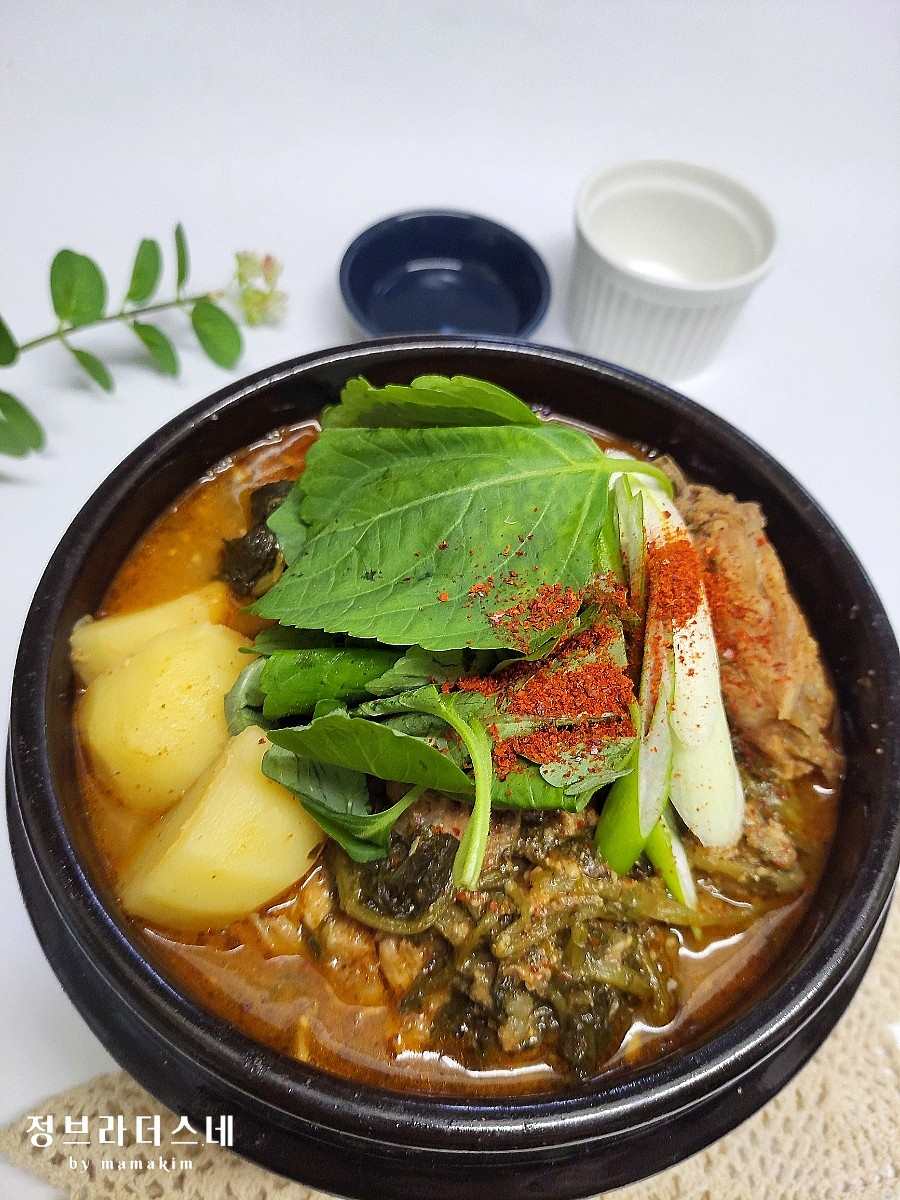Spicy Pork Backbone Stew with Napa Cabbage
Rich & Hearty Gamjatang: Easy Pressure Cooker Recipe with Pork Backbone and Napa Cabbage (Perfect Hangover Soup!)

Indulge in the deeply savory and mildly spicy flavors of Gamjatang, a comforting Korean stew made with tender pork backbones and wonderfully chewy napa cabbage. This dish is perfect for warding off the chill on a cool day or as a satisfying accompaniment to a drink after work. While often perceived as complicated to make at home, this pressure cooker recipe simplifies the process significantly. Enjoy a hearty bowl filled with succulent meat, flavorful cabbage, and soft potatoes in a robust broth. Let’s get started on this easy Gamjatang recipe!
Main Ingredients- 1.6kg Pork backbone
- 2 handfuls Napa cabbage (or dried napa cabbage)
- 3 small potatoes
- 1 handful Perilla leaves (or perilla chips)
- 1 liter Water
Seasoning- 2 Tbsp Doenjang (fermented soybean paste)
- 2 Tbsp Gochugaru (red pepper flakes)
- 2 Tbsp Minced garlic
- 3 Tbsp Anchovy sauce (or fish sauce)
- 3 shakes Black pepper
- 1/3 Tbsp Dasida (or MSG/flavor enhancer)
- 3 generous Tbsp Perilla seed powder
- 2 Tbsp Doenjang (fermented soybean paste)
- 2 Tbsp Gochugaru (red pepper flakes)
- 2 Tbsp Minced garlic
- 3 Tbsp Anchovy sauce (or fish sauce)
- 3 shakes Black pepper
- 1/3 Tbsp Dasida (or MSG/flavor enhancer)
- 3 generous Tbsp Perilla seed powder
Cooking Instructions
Step 1
Many people opt to buy Gamjatang or hangover soup due to the long cooking time and the effort required to prepare the pork backbones and napa cabbage. However, if you have easy access to fresh napa cabbage or its dried form (siraregi), you can easily make delicious and hearty Gamjatang at home. Today, I’ll guide you through a simplified Gamjatang recipe using a pressure cooker for quicker results.

Step 2
It’s crucial to soak the 1.6kg of pork backbone in cold water to remove blood. This step ensures a cleaner taste and a clearer broth. I usually soak it for about an hour, changing the water twice if a lot of blood is released. Proper blood removal is key to a refined Gamjatang.

Step 3
Place the blood-removed pork backbones in a pot, cover them with water, and add a few whole peppercorns. Bring to a boil over high heat. Once boiling, blanch the pork bones for about 2-3 minutes, just until the outer color changes. This quick blanching helps remove impurities and clarifies the broth.

Step 4
Immediately transfer the blanched pork backbones to cold water and rinse each piece thoroughly under running water. Carefully scrub away any remaining impurities or bone fragments from the pot to ensure a clean-tasting stew free from any gamey odors.

Step 5
Transfer the cleaned pork backbones to your pressure cooker. We’ll prepare the napa cabbage by seasoning it and then cook it together with the pork backbones. The savory essence of the cabbage will deepen the overall flavor of the Gamjatang.

Step 6
In a bowl, combine all the seasoning ingredients and mix them well by hand. Add 2 Tbsp doenjang, 2 Tbsp gochugaru, 2 Tbsp minced garlic, 3 Tbsp anchovy sauce, and 3 shakes of black pepper. Gently massage the seasonings into the napa cabbage, ensuring it’s evenly coated for optimal flavor infusion.

Step 7
Arrange the prepared pork backbones in the pressure cooker, then top with the seasoned napa cabbage. Pour in 1 liter of water. Your pressure cooker is now ready for cooking, allowing the ingredients and seasonings to meld into a rich, deep flavor.

Step 8
Close the pressure cooker lid and begin cooking over high heat. Once the pressure indicator starts to whistle, reduce the heat to medium and cook for 13 minutes. Allow the pressure to release naturally and let it steam for a bit. Carefully open the pressure cooker; the pork backbones and napa cabbage should be exceptionally tender and perfectly cooked.

Step 9
Add the prepared potatoes to the tender pork and cabbage, and bring it to a boil once more. If there’s excessive oil floating on top, skim it off for a cleaner broth. Taste and adjust the seasoning; use salt for saltiness and Dasida (1/3 Tbsp) to enhance the umami. Finally, stir in a generous 3 Tbsp of perilla seed powder for a nutty aroma and rich texture. Adjust the amount of perilla seed powder to your preference.

Step 10
Once the potatoes are tender, your delicious Gamjatang is ready! Garnish generously with thinly sliced perilla leaves and green onions for a visually appealing and flavorful finish. Enjoy this warm, comforting bowl of Gamjatang!



